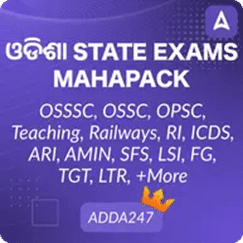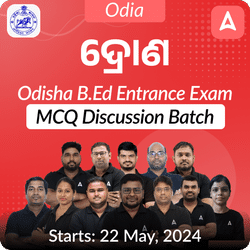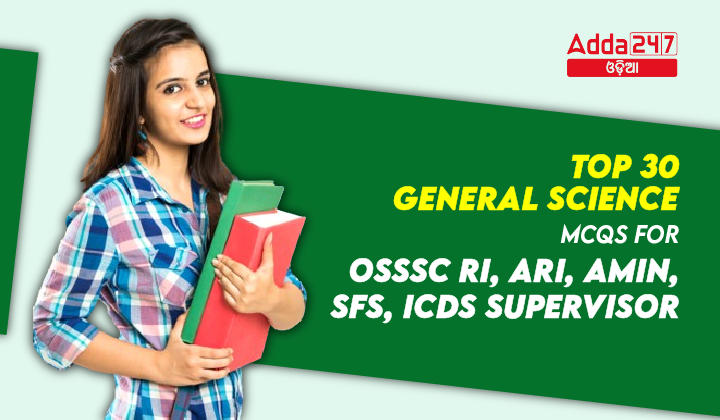General Studies is a crucial component of various competitive exams like OSSSC RI, ARI, Amin, SFS, and ICDS Supervisor. It encompasses a wide range of topics, from current affairs to history, geography, polity, and more. To excel in these exams, it’s essential to have a strong grasp of general knowledge. Here, we present a curated list of the top 30 Multiple Choice Questions (MCQs) that are commonly encountered in these exams, covering diverse subjects to help you prepare effectively.
Top 30 General Science MCQS For OSSSC RI,ARI, Amin, SFS, ICDS Supervisor
- Which vitamin is known as Folic Acid?
[A] Vitamin B6
[B] Vitamin B7
[C] Vitamin B9
[D] Vitamin B12
Correct Answer: C
Explanation: Vitamin B9 is also known as Folic Acid. - Which vitamin is known as Cobalamin?
[A] Vitamin B6
[B] Vitamin B7
[C] Vitamin B9
[D] Vitamin B12
Correct Answer: D
Explanation: Vitamin B12 is also known as Cobalamin. - Which vitamin is known as Ascorbic Acid?
[A] Vitamin B1
[B] Vitamin B2
[C] Vitamin B3
[D] Vitamin C
Correct Answer: D
Explanation: Vitamin C is also known as Ascorbic Acid. - Which vitamin is known as Calciferol?
[A] Vitamin A
[B] Vitamin D
[C] Vitamin E
[D] Vitamin K
Correct Answer: B
Explanation: Vitamin D is also known as Calciferol. - Which vitamin is known as Tocopherol?
[A] Vitamin A
[B] Vitamin D
[C] Vitamin E
[D] Vitamin K
Correct Answer: C
Explanation: Vitamin E is also known as Tocopherol. - Which vitamin is known as Phytonadione?
[A] Vitamin A
[B] Vitamin D
[C] Vitamin E
[D] Vitamin K
Correct Answer: D
Explanation: Vitamin K is also known as Phytonadione. - Which of the following vitamins is water-soluble?
[A] Vitamin A
[B] Vitamin D
[C] Vitamin C
[D] Vitamin E
Correct Answer: C
Explanation: Vitamin C is water-soluble. - Which of the following vitamins is fat-soluble?
[A] Vitamin B1
[B] Vitamin B2
[C] Vitamin B3
[D] Vitamin K
Correct Answer: D
Explanation: Vitamin K is fat-soluble. - Which of the following is a water-soluble vitamin?
[A] Vitamin A
[B] Vitamin E
[C] Vitamin B12
[D] Vitamin K
Correct Answer: C
Explanation: Vitamin B12 is water-soluble. - Which vitamin is essential for blood clotting?
[A] Vitamin A
[B] Vitamin D
[C] Vitamin E
[D] Vitamin K
Correct Answer: D
Explanation: Vitamin K is essential for blood clotting. - Which vitamin helps in calcium absorption?
[A] Vitamin A
[B] Vitamin B12
[C] Vitamin D
[D] Vitamin K
Correct Answer: C
Explanation: Vitamin D helps in calcium absorption. - Which vitamin deficiency causes scurvy?
[A] Vitamin A
[B] Vitamin C
[C] Vitamin D
[D] Vitamin E
Correct Answer: B
Explanation: Vitamin C deficiency causes scurvy. - Which of the following correctly defines “Nacre”?
[A] A type of rare gemstone
[B] A hard iridescent substance forming the inner layer of certain shells
[C] A type of marine plant
[D] The outer shell of crustaceans
Correct Answer: B
Explanation: Nacre, or mother-of-pearl, is a hard, iridescent substance forming the inner layer of certain shells. - What type of stem does an onion have?
[A] Rhizome
[B] Bulb
[C] Tuber
[D] Corm
Correct Answer: B
Explanation: An onion has a bulb stem. - Which scientist is known for developing DNA fingerprinting in India?
[A] Samir K Brahmachari
[B] Prof M Vijayan
[C] Dr Lalji Singh
[D] Kanury Venkata Subba Rao
Correct Answer: C
Explanation: Dr. Lalji Singh is best known for developing DNA fingerprinting in India. - What is the antigen present on red cells of Blood Group B?
[A] A antigen
[B] B antigen
[C] Both A and B antigens
[D] No antigens
Correct Answer: B
Explanation: Blood Group B has B antigen on its red cells. - What does the term biocenosis refer to?
[A] A type of fossilized plant
[B] Community of organisms occupying an area
[C] A type of marine ecosystem
[D] Study of energy transformations
Correct Answer: B
Explanation: Biocenosis refers to a community of organisms occupying an area. - Which is the smallest human chromosome?
[A] Chromosome 10
[B] Chromosome 16
[C] Chromosome 20
[D] Chromosome 21
Correct Answer: D
Explanation: Chromosome 21 is the smallest human chromosome. - Two vectors are equal if:
[A] They have equal magnitude but different directions
[B] They have equal magnitude and the same direction
[C] They have different magnitudes but the same direction
[D] They have different magnitudes and different directions
Correct Answer: B
Explanation: Two vectors are equal if they have equal magnitude and the same direction. - What does the universal gravitational constant represent?
[A] Force of attraction between two unit masses at unit distance
[B] Force of repulsion between two unit masses at unit distance
[C] Magnetic force between two unit charges
[D] Electrical force between two unit charges
Correct Answer: A
Explanation: The universal gravitational constant is the force of attraction between two unit masses at unit distance. - What do we call the nuclides that have the same mass number?
[A] Isotopes
[B] Isobars
[C] Isotones
[D] Such species don’t exist
Correct Answer: B
Explanation: Nuclides with the same mass number are called isobars. - Which substance was used as a moderator in the CIRUS reactor?
[A] Heavy water
[B] Water
[C] Solid graphite
[D] No moderator was used
Correct Answer: A
Explanation: The CIRUS reactor used heavy water as a moderator. - What do we call the reaction when an acid and a base react together to form salt and water?
[A] Reduction Reaction
[B] Oxidation Reaction
[C] Neutralisation Reaction
[D] Combination Reaction
Correct Answer: C
Explanation: The reaction between an acid and a base to form salt and water is called a Neutralisation Reaction. - What is the bond formed due to electrostatic attraction known as?
[A] Covalent bond
[B] Electrovalent bond
[C] Electromagnetic bond
[D] Polar bond
Correct Answer: B
Explanation: The bond formed due to electrostatic attraction between positive and negative ions is called an Electrovalent bond, also known as an Ionic bond. - Which of the following is not a compound of carbon?
[A] Cinnabar
[B] Acetic acid
[C] Chloroform
[D] Methane
Correct Answer: A
Explanation: Cinnabar (Mercury Sulphide) is not a compound of carbon; it is a compound of mercury and sulphur. - Which company developed the ‘Omicron-specific mRNA-based Booster vaccine’?
[A] Gennova
[B] Bharat Biotech
[C] Serum Institute
[D] Dr Reddy’s Labs
Correct Answer: A
Explanation: Gennova Biopharmaceuticals Ltd. developed the Omicron-specific mRNA-based Booster vaccine. - What is the name of the closest supermassive black hole to the Earth?
[A] Tarzan A
[B] Sagittarius A
[C] Titan A
[D] Suzlon A
Correct Answer: B
Explanation: Sagittarius A is the closest supermassive black hole to Earth. - Where are genes located?
[A] In the mitochondria
[B] In the ribosomes
[C] In the chromosomes within the cell nucleus
[D] In the cell membrane
Correct Answer: C
Explanation: Genes are located in chromosomes, which are found within the cell nucleus. - How many chromosomes does a normal human cell contain?
[A] 22 pairs, for a total of 44 chromosomes
[B] 23 pairs, for a total of 46 chromosomes
[C] 24 pairs, for a total of 48 chromosomes
[D] 25 pairs, for a total of 50 chromosomes
Correct Answer: B
Explanation: A normal human cell contains 23 pairs of chromosomes, for a total of 46 chromosomes. - What is a trait?
[A] A type of chromosome
[B] A gene-determined characteristic that is often determined by more than one gene
[C] A segment of RNA
[D] A structure within the cell nucleus
Correct Answer: B
Explanation: A trait is a gene-determined characteristic that is often determined by more than one gene. - How many genes can a single chromosome contain?
[A] One to ten
[B] Tens to hundreds
[C] Hundreds to thousands
[D] Thousands to millions
Correct Answer: C
Explanation: A chromosome can contain hundreds to thousands of genes.















